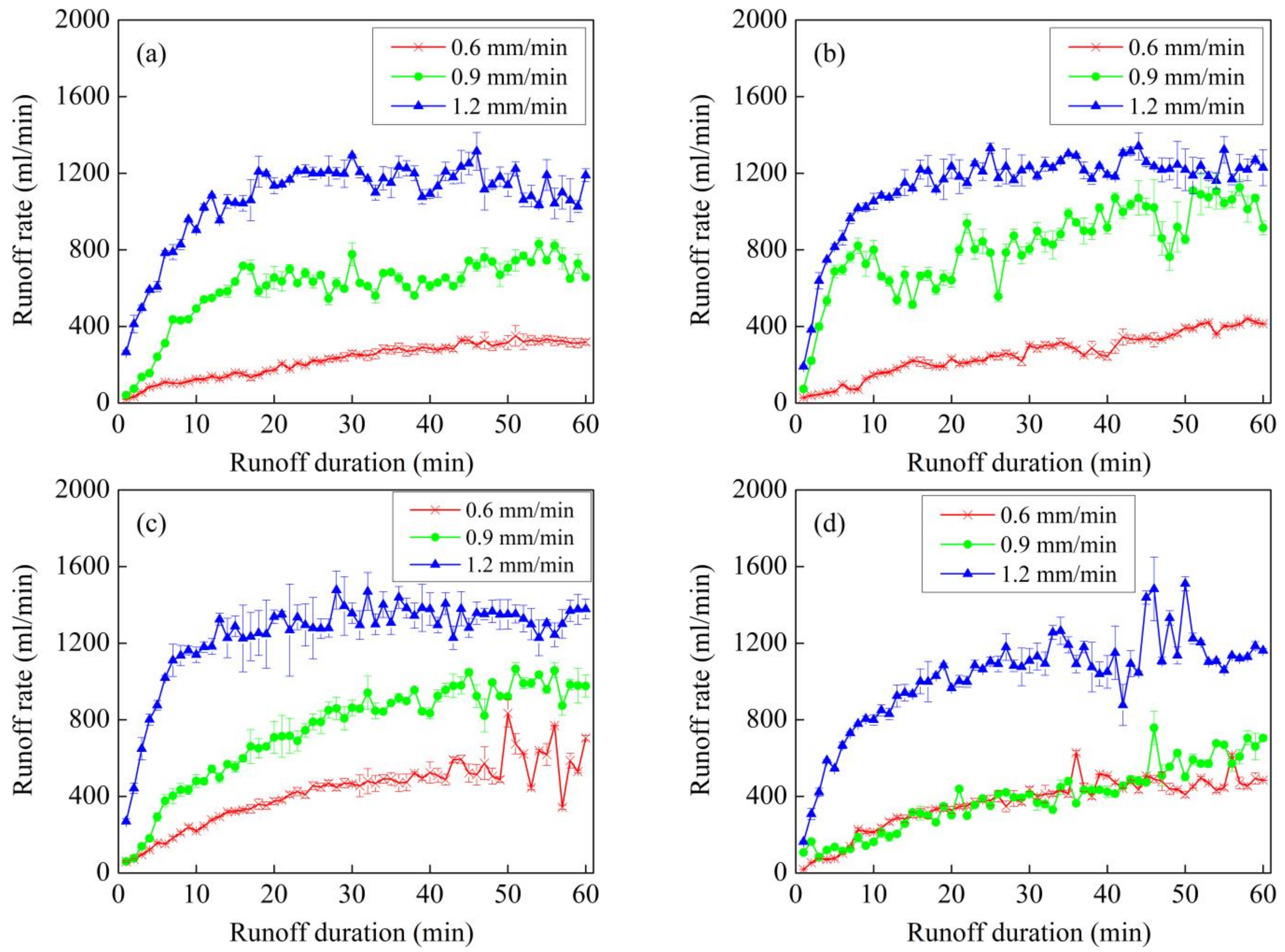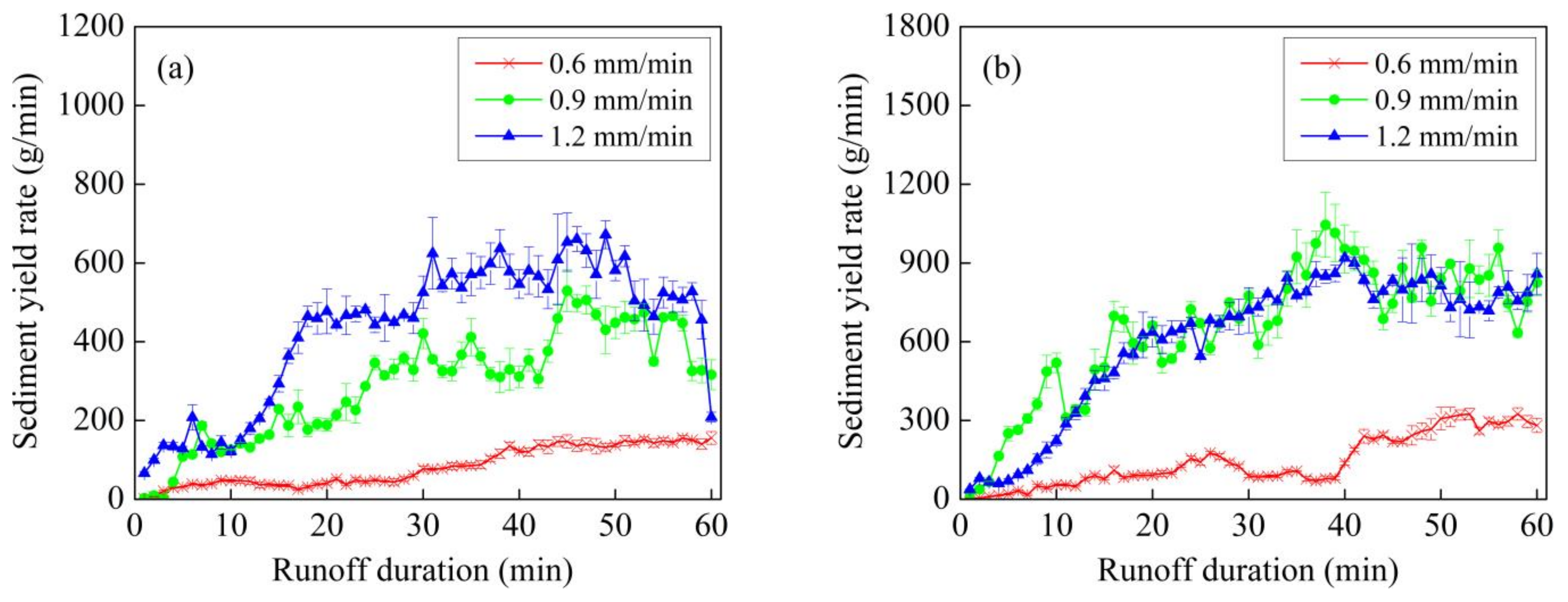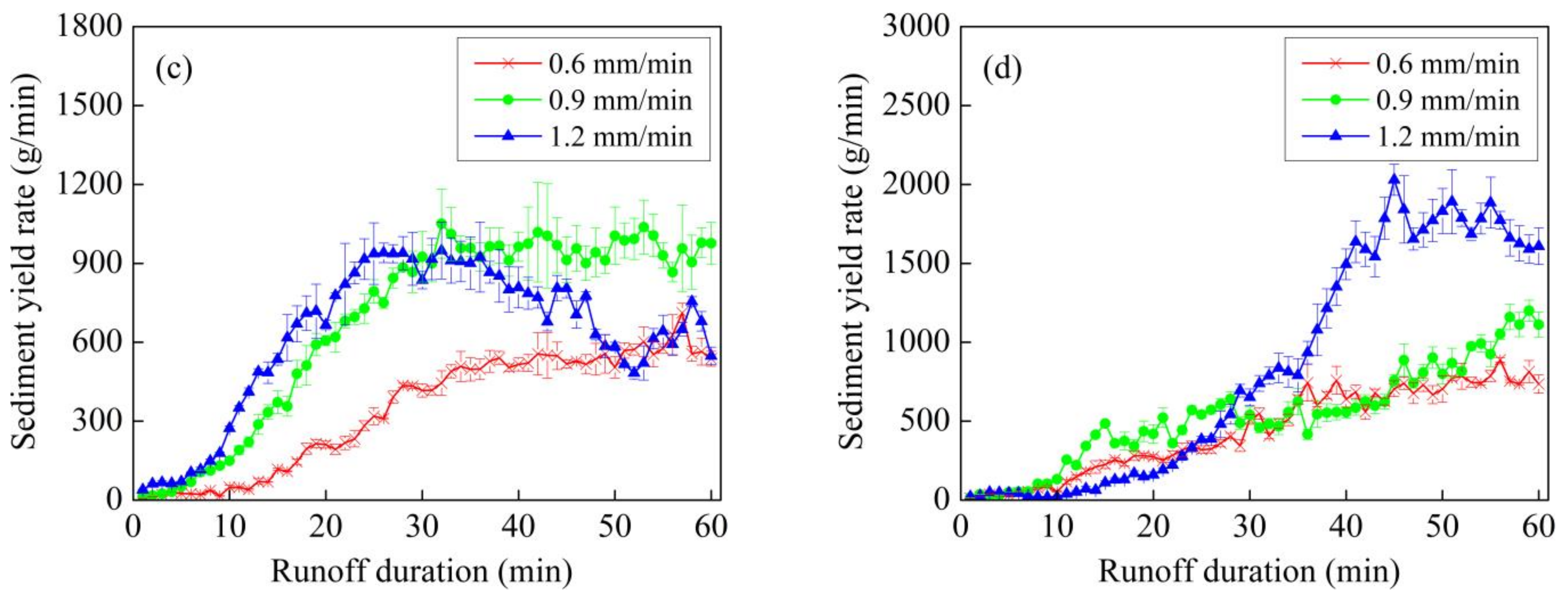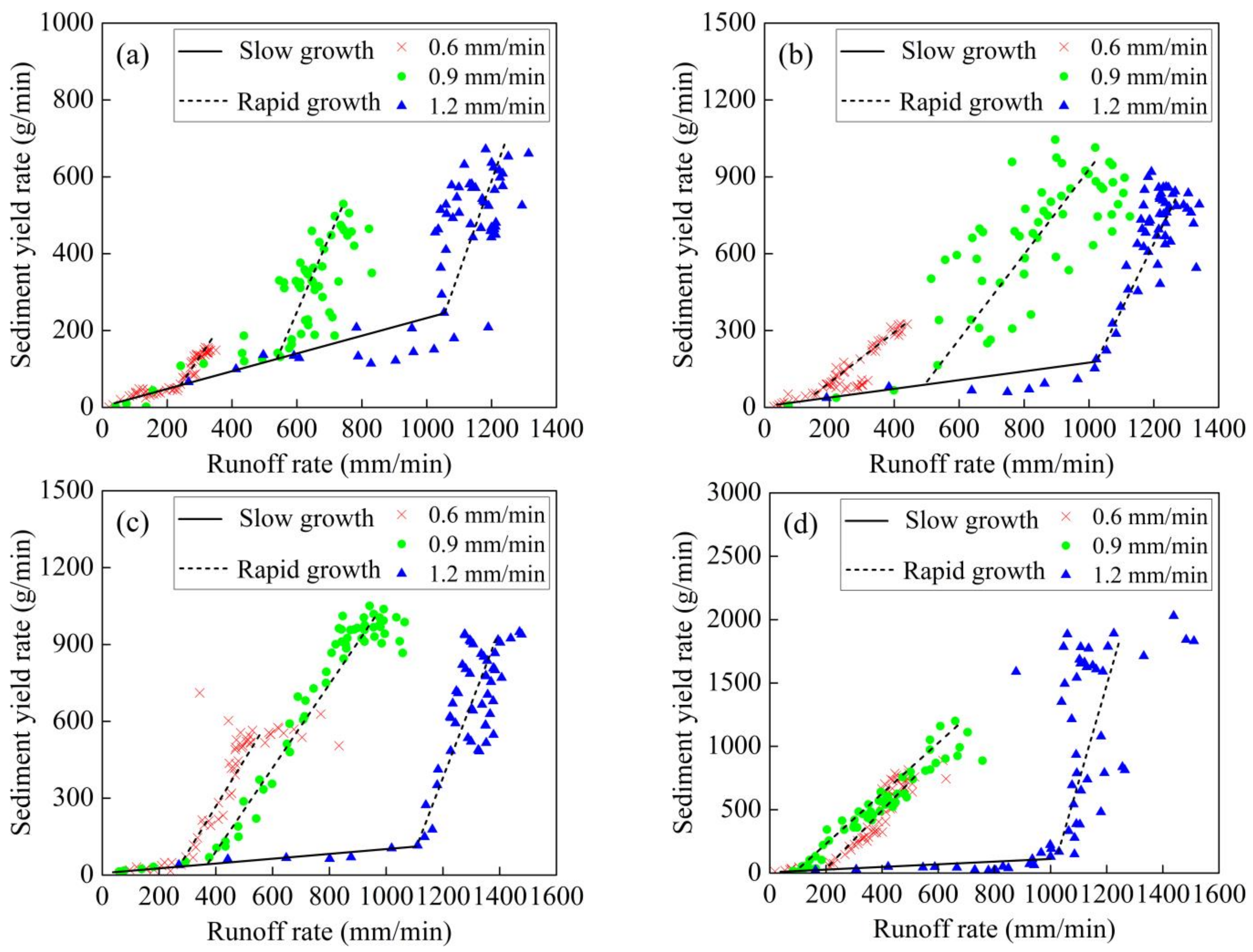Interactive Effects of Rainfall Intensity and Initial Thaw Depth on Slope Erosion
Abstract
:1. Introduction
2. Materials and Methods
2.1. Material and Device
2.2. Experimental Design
2.3. Methods
3. Results
3.1. Characteristics of Runoff and Sediment Yield under Different Treatments
3.1.1. Initial Runoff Time and Rills Occurrence Time under Different Treatments
3.1.2. Runoff Process and Characteristics
3.1.3. Sediment Yield Process and Characteristics
3.2. Runoff-Sediment Relationship under Different Treatments
3.2.1. Relationship between Runoff Rate and Sediment Yield Rate
3.2.2. Correlation between Accumulative Runoff and Accumulative Sediment Yield
3.3. Contributions of Rainfall Intensity and Initial Thaw Depth on Erosion
4. Discussion
4.1. Effects of Rainfall Intensity and Initial Thaw Depth on Runoff and Sediment Yield Processes
4.2. Effects of Rainfall Intensity and Initial Thaw Depth on Soil Erosion Amount
4.3. Implications for the Relationship between Rainfall Intensity and Soil Thawing Depth and Erosion
5. Conclusions
Author Contributions
Funding
Institutional Review Board Statement
Informed Consent Statement
Data Availability Statement
Conflicts of Interest
References
- Wang, T.; Li, P.; Ren, Z.P.; Xu, G.C.; Li, Z.B.; Yang, Y.Y.; Yao, J.W. Effects of freeze-thaw on soil erosion processes and sediment selectivity under simulated rainfall. J. Arid. Land 2017, 9, 234–243. [Google Scholar] [CrossRef] [Green Version]
- Bochove, E.V.; Danielle, P.; Pelletier, F. Effects of freeze–thaw and soil structure on nitrous oxide produced in a clay soil. Soil Sci. Soc. Am. J. 2000, 64, 1638–1643. [Google Scholar] [CrossRef]
- Su, Y.Y.; Li, P.; Ren, Z.P.; Xiao, L.; Zhang, H. Freeze-thaw effects on erosion process in loess slope under simulated rainfall. J. Arid. Land 2020, 12, 937–949. [Google Scholar] [CrossRef]
- Wang, T.; Li, P.; Li, Z.B.; Hou, J.M.; Xiao, L.; Ren, Z.P.; Xu, G.C.; Yu, K.X.; Su, Y.Y. The effects of freeze–thaw process on soil water migration in dam and slope farmland on the Loess Plateau, China. Sci. Total Environ. 2019, 666, 721–730. [Google Scholar] [CrossRef]
- Zhao, B.H.; Li, Z.B.; Li, P.; Xu, G.C.; Gao, H.D.; Cheng, Y.T.; Chang, E.H.; Yuan, L.; Zhang, Y.; Feng, Z.H. Spatial distribution of soil organic carbon and its influencing factors under the condition of ecological construction in a hilly-gully watershed of the Loess Plateau, China. Geoderma 2017, 296, 10–17. [Google Scholar] [CrossRef]
- Zhang, Y.; Li, P.; Liu, X.J.; Xiao, L.; Shi, P.; Zhao, B.H. Effects of farmland conversion on the stoichiometry of carbon, nitrogen, and phosphorus in soil aggregates on the Loess Plateau of China. Geoderma 2019, 351, 188–196. [Google Scholar] [CrossRef]
- Wang, T.; Li, P.; Liu, Y.; Hou, J.M.; Li, Z.B.; Ren, Z.P.; Cheng, S.D.; Zhao, J.H.; Hinkelmann, R. Experimental investigation of freeze-thaw meltwater compound erosion and runoff energy consumption on loessal slopes. Catena 2020, 185, 104310. [Google Scholar] [CrossRef]
- Kirkby, M.J. Modeling water erosion processes. In Soil Erosion; Kirkby, M.J., Morgan, R.P.C., Eds.; Wiley: Chichester, UK, 1980; pp. 183–196. [Google Scholar]
- Zuzel, J.; Pikul, J. Effects of straw mulch on runoff and erosion from small agricultural plots in northeastern oregon. Soil Sci. 1993, 156, 111–117. [Google Scholar] [CrossRef]
- Wang, L.; Shi, Z.H.; Wu, G.L.; Fang, N.F. Freeze/thaw and soil moisture effects on wind erosion. Geomorphology. 2014, 207, 141–148. [Google Scholar] [CrossRef]
- Øygarden, L. Rill and gully development during extreme winter runoff event in Norway. Catena 2003, 50, 217–242. [Google Scholar] [CrossRef]
- Sharratt, B.S.; Lindstrom, M.J.; Benoit, G.R.; Young, R.A.; Wilts, A. Runoff and soil erosion during spring thaw in the northern US Corn Belt. J. Soil Water Conserv. 2000, 55, 487–494. [Google Scholar]
- Rui, D.H.; Ji, M.C.; Nakamur, D.; Suzuki, T. Experimental study on gravitational erosion process of vegetation slope under freeze–thaw. Cold Reg. Sci. Technol. 2018, 151, 168–178. [Google Scholar] [CrossRef]
- Ma, Q.; Zhang, K.; Jabro, J.D.; Ren, L.; Liu, H. Freeze–thaw cycles effects on soil physical properties under different degraded conditions in Northeast China. Environ. Earth Sci. 2019, 78, 321. [Google Scholar] [CrossRef]
- Zhang, X.C.; Nearing, M.A.; Norton, L.D.; Miller, W.P.; West, L.T. Modeling inter rill sediment delivery. Soil Sci. Soc. Am. J. 1998, 62, 438. [Google Scholar] [CrossRef]
- Assouline, S.; Ben, H.M. Effects of rainfall intensity and slope gradient on the dynamics of interrill erosion during soil surface sealing. Catena 2006, 66, 211–220. [Google Scholar] [CrossRef]
- Nearing, M.A.; Polyakov, V.O. Sediment transport in rill flow under deposition and detachment conditions. Catena 2003, 51, 33–43. [Google Scholar]
- Kinnell, P.I.A. Raindrop-impact-induced erosion processes and prediction: A review. Hydrol. Processes 2005, 19, 2815–2844. [Google Scholar] [CrossRef]
- Saxton, K.E.; Mccool, D.K.; Papendick, R.I. Slot mulch for runoff and erosion control. J. Soil Water Conserv. 1981, 36, 44–47. [Google Scholar]
- Wang, T.; Li, P.; Hou, J.M.; Li, Z.B.; Ren, Z.P.; Cheng, S.D.; Xu, G.C.; Su, Y.Y.; Wang, F. Response of the Meltwater Erosion to Runoff Energy Consumption on Loessal Slopes. Water 2018, 10, 1522. [Google Scholar] [CrossRef] [Green Version]
- Pikul, J.L.; Aase, J.K. Fall Contour Ripping Increases Water Infiltration into Frozen Soil. Soil Sci. Soc. Am. J. 1998, 62, 1017. [Google Scholar] [CrossRef] [Green Version]
- Wu, Y.Y.; Wei, O.Y.; Hao, Z.C.; Lin, C.Y.; Liu, H.B.; Wang, Y.D. Assessment of soil erosion characteristics in response to temperature and precipitation in a freeze-thaw watershed. Geoderma 2018, 328, 56–65. [Google Scholar] [CrossRef]
- Sun, B.Y.; Xiao, J.B.; Li, Z.B.; Ma, B.; Zhang, L.T.; Huang, Y.L.; Bai, L.F. An analysis of soil detachment capacity under freeze-thaw conditions using the Taguchi method. Catena 2018, 162, 100–107. [Google Scholar] [CrossRef]
- Chang, E.H.; Li, P.; Li, Z.B.; Xiao, L.; Zhao, B.H.; Su, Y.Y.; Feng, Z.H. Using water isotopes to analyze water uptake during vegetation succession on abandoned cropland on the Loess Plateau, China. Catena 2019, 181, 104095. [Google Scholar] [CrossRef]
- Shi, P.; Qin, Y.; Liu, Q.; Zhu, T.T.; Li, Z.B.; Li, P.; Ren, Z.P.; Liu, Y.; Wang, F.C. Soil respiration and response of carbon source changes to vegetation restoration in the Loess Plateau, China. Sci. Total Environ. 2019, 707, 135507. [Google Scholar] [CrossRef] [PubMed]
- Shi, P.; Feng, Z.H.; Gao, H.D.; Li, P.; Xiao, L. Has “Grain for Green” threaten food security on the Loess Plateau of China? Ecosyst. Health Sustain. 2020, 6, 1709560. [Google Scholar] [CrossRef] [Green Version]
- Shi, P.; Zhang, Y.; Zhang, Y.; Yu, Y.; Li, P.; Li, Z.B.; Xiao, L.; Xu, G.C.; Zhu, T.T. Land-use types and slope topography affect the soil labile carbon fractions in the Loess hilly-gully area of Shaanxi, China. Arch. Agron. Soil Sci. 2020, 66, 638–650. [Google Scholar] [CrossRef]
- Wang, S.J.; Wang, X.F.; Wang, L. Status and Ecological Functions of Water and Heat During Non-growing Period in Loess Plateau. Bull. Soil Water Conserv. 2017, 37, 284–288, (In Chinese with English Abstract). [Google Scholar]
- Zhao, J.B.; Cao, J.J.; Zhang, C.; Gulzat, H.; Hu, J. The soil infiltration research of the Quanji township in the northwest Qinghai Lake area. J. Earth Environ. 2010, 1, 175–182, (In Chinese with English Abstract). [Google Scholar]
- Wei, X.; Li, X.G.; Huang, C.H. Impacts of freeze-thaw cycles on runoff and sediment yield of slope land. Trans. Chin. Soc. Agric. Eng. 2015, 31, 157–163, (In Chinese with English Abstract). [Google Scholar]
- Xu, Y.; Tian, J.L.; Liu, P.L.; Xu, X.X. Topographic Differentiation Simulation of Soil and Water Loss of Slope Farmland in Loess Plateau. J. Soil Water Conserv. 2005, 19, 20–23, 27, (In Chinese with English Abstract). [Google Scholar]
- Ban, Y.Y.; Lei, T.W.; Chen, C.; Liu, Z.Q. Study on the facilities and procedures for meltwater erosion of thawed soil. Int. Soil Water Conserv. Res. 2016, 4, 142–147. [Google Scholar] [CrossRef] [Green Version]
- Su, Y.Y.; Li, P.; Ren, Z.P.; Xiao, L.; Wang, T.; Zhang, Y. Slope Erosion and Hydraulics during Thawing of the Sand-Covered Loess Plateau. Water 2020, 12, 2461. [Google Scholar] [CrossRef]
- Ban, Y.Y.; Lei, T.W.; Liu, Z.Q.; Chen, C. Comparative study of erosion processes of thawed and non-frozen soil by concentrated meltwater flow. Catena 2017, 148, 153–159. [Google Scholar] [CrossRef]
- Lei, T.W.; Nearing, M.A.; Haghighi, K.; Braits, V.F. Rill erosion and morphological evolution: A simulation model. Water Resour. Res. 1998, 34, 3157–3168. [Google Scholar] [CrossRef]
- Wirtz, S.; Seeger, M.; Ries, J.B. Field experiments for understanding and quantification of rill erosion processes. Catena 2012, 91, 21–34. [Google Scholar] [CrossRef]
- Chen, X.Y.; Zhao, Y.; Mi, H.X.; Mo, B. Estimating rill erosion process from eroded morphology in flume experiments by volume replacement method. Catena 2015, 136, 135–140. [Google Scholar] [CrossRef]
- Wu, B.; Wang, Z.L.; Zhang, Q.W.; Shen, N.; Liu, J. Response of soil detachment rate by raindrop-affected sediment-laden sheet flow to sediment load and hydraulic parameters within a detachment-limited sheet erosion system on steep slopes on Loess Plateau, China. Soil Tillage Res. 2019, 185, 9–16. [Google Scholar] [CrossRef]
- Liu, J.; Fan, H.M.; Zhou, L.L.; Wu, M.; Chai, Y.; Liu, Y.H. Study on effects of rainfall in the spring thaw period on black soil slope erosion. J. Soil Water Conserv. 2009, 23, 64–67, (In Chinese with English Abstract). [Google Scholar]
- Ting, J.M.; Torrence, M.R.; Ladd, C.C. Mechanisms of Strength for Frozen Sand. J. Geotech. Eng. 1983, 109, 1286–1302. [Google Scholar] [CrossRef]
- Zhou, L.L.; Wang, T.L.; Fan, H.M.; Wu, M.; Chai, Y.; Zhang, D.Y. Effects of incompletely thawed layer on black soil slope rainfall erosion. J. Soil Water Conserv. 2009, 23, 1+4-37, (In Chinese with English Abstract). [Google Scholar]
- Bajracharya, R.M.; Lal, R. Seasonal soil loss and erodibility variation on a miamian silt loam soil. Soil Sci. Soc. Am. J. 1992, 56, 1560. [Google Scholar] [CrossRef]
- Fan, H.M.; Liu, Y.J.; Xu, X.Q.; Wu, M.; Zhou, L.L. Simulation of rill erosion in black soil and albic soil during the snowmelt period. Acta Agric. Scand. Sect. B-Soil Plant Sci. 2017, 67, 510–517. [Google Scholar] [CrossRef]
- Li, G.Y.; Fan, H.M. Effect of freeze-thaw on water stability of aggregates in a black aoil of northeast China. Pedosphere 2014, 24, 285–290. [Google Scholar] [CrossRef]
- Soto, B.; Díaz-Fierros, F. Runoff and soil erosion from areas of burnt scrub: Comparison of experimental results with those predicted by the WEPP model. Catena 1998, 31, 257–270. [Google Scholar] [CrossRef]
- Meyer, L.D.; Foster, G.R.; Nikolov, S. Effect of flow rate and canopy on rill erosion. Trasactions ASAE 1975, 18, 0905–0911. [Google Scholar] [CrossRef]
- Elliot, W.J.; Laflen, J.M. A Process-based rill erosion model. Trasactions ASAE 1998, 136, 65–72. [Google Scholar]
- Wang, W.L.; Lei, A.L.; Li, Z.B.; Tang, K.L. Study on dynamic mechanism of rills, shallow furrows and gully in the soil erosion chain. Adv. Water Sci. 2003, 14, 471–475, (In Chinese with English Abstract). [Google Scholar]
- Kimaro, D.N.; Poesen, J.; Msanya, B.M.; Deckers, J.A. Magnitude of soil erosion on the northern slope of the Uluguru Mountains, Tanzania: Interrill and rill erosion. Catena 2008, 75, 38–44. [Google Scholar] [CrossRef]
- Bewket, W.; Sterk, G. Assessment of soil erosion in cultivated fields using a survey methodology for rills in the Chemoga watershed, Ethiopia. Agric. Ecosyst. Environ. 2003, 97, 81–93. [Google Scholar] [CrossRef]






| State of Slope | Initial Thaw Depth (cm) | Treatments | Rainfall Intensity (mm/min) | Slope (°) | Initial Soil Moisture Content (%) | Runoff Duration (min) |
|---|---|---|---|---|---|---|
| Freeze–thaw slopes | 0 | FT0 | 0.6 | 15 | 15 | 60 |
| 0.9 | 15 | 15 | 60 | |||
| 1.2 | 15 | 15 | 60 | |||
| 2 | FT2 | 0.6 | 15 | 15 | 60 | |
| 0.9 | 15 | 15 | 60 | |||
| 1.2 | 15 | 15 | 60 | |||
| 4 | FT4 | 0.6 | 15 | 15 | 60 | |
| 0.9 | 15 | 15 | 60 | |||
| 1.2 | 15 | 15 | 60 | |||
| 6 | FT6 | 0.6 | 15 | 15 | 60 | |
| 0.9 | 15 | 15 | 60 | |||
| 1.2 | 15 | 15 | 60 |
| Treatments | FT0 | FT2 | FT4 | FT6 | ||||||||
|---|---|---|---|---|---|---|---|---|---|---|---|---|
| Rainfall Intensity (mm/min) | 0.6 | 0.9 | 1.2 | 0.6 | 0.9 | 1.2 | 0.6 | 0.9 | 1.2 | 0.6 | 0.9 | 1.2 |
| Initial Runoff Time (min) | 10.13 | 5.47 | 2.58 | 17.00 | 12.83 | 5.37 | 18.80 | 16.44 | 6.75 | 38.26 | 31.38 | 14.01 |
| Rills Occurrence Time (min) | 16 | 10 | 7 | 12 | 8 | 8 | 15 | 7 | 7 | 11 | 11 | 12 |
| Treatments | Rainfall Intensity (mm/min) | Variation Range of Runoff Rate (mL/min) | Average Runoff Rate (mL/min) | CV (%) |
|---|---|---|---|---|
| FT0 | 0.6 | 20.42–350.24 | 225.51 | 39.74 |
| 0.9 | 40.88–830.91 | 599.19 | 28.83 | |
| 1.2 | 266.05–1314.42 | 1067.06 | 20.10 | |
| FT2 | 0.6 | 28.89–440.05 | 256.41 | 43.13 |
| 0.9 | 73.89–1126.51 | 821.3 | 29.91 | |
| 1.2 | 191.29–1340.45 | 1140.38 | 18.36 | |
| FT4 | 0.6 | 59.52–833.9 | 425.23 | 39.57 |
| 0.9 | 59.98–1065.54 | 747.16 | 24.59 | |
| 1.2 | 269.72–1477.49 | 1244.58 | 17.82 | |
| FT6 | 0.6 | 18.69–627.71 | 365.62 | 37.37 |
| 0.9 | 83.33–757.98 | 392.92 | 44.01 | |
| 1.2 | 163.02–1510.99 | 1019.07 | 24.55 |
| Treatments | Rainfall Intensity (mm/min) | Variation Range of Sediment Yield Rate (g/min) | Average Sediment Yield Rate (g/min) | CV (%) |
|---|---|---|---|---|
| FT0 | 0.6 | 1.13–155.81 | 83.35 | 58.61 |
| 0.9 | 2.04–529.54 | 293.38 | 46.80 | |
| 1.2 | 66.21–672.04 | 431.15 | 41.36 | |
| FT2 | 0.6 | 4.04–324.98 | 145.38 | 68.11 |
| 0.9 | 7.94–1045.01 | 653.08 | 38.66 | |
| 1.2 | 37.32–919.63 | 608.50 | 43.30 | |
| FT4 | 0.6 | 5.93–711.55 | 347.43 | 63.25 |
| 0.9 | 13.68–1051.00 | 688.27 | 51.33 | |
| 1.2 | 39.36–949.16 | 627.14 | 44.03 | |
| FT6 | 0.6 | 12.1–888.36 | 443.77 | 60.96 |
| 0.9 | 16.48–1200.20 | 538.17 | 57.97 | |
| 1.2 | 19.52–2029.92 | 838.52 | 86.72 |
| Rainfall Intensity (mm/min) | Treatments | Stage I | Stage II | ||
|---|---|---|---|---|---|
| 0.6 | FT0 | y = 0.253x − 0.009 | R2 = 0.9994 ** | y = 0.364x − 0.227 | R2 = 0.9835 ** |
| FT2 | y = 0.345x − 0.026 | R2 = 0.9964 ** | y = 0.573x − 0.359 | R2 = 0.9816 ** | |
| FT4 | y = 0.372x − 0.078 | R2 = 0.9388 ** | y = 0.962x − 0.859 | R2 = 0.9987 ** | |
| FT6 | y = 0.608x − 0.133 | R2 = 0.9766 ** | y = 1.389x − 1.571 | R2 = 0.9939 ** | |
| 0.9 | FT0 | y = 0.336x − 0.040 | R2 = 0.9924 ** | y = 0.537x − 1.424 | R2 = 0.9910 ** |
| FT2 | y = 0.468x − 0.263 | R2 = 0.9842 ** | y = 0.871x+0.029 | R2 = 0.9992 ** | |
| FT4 | y = 0.275x − 0.053 | R2 = 0.9806 ** | y = 1.018x − 1.239 | R2 = 0.9993 ** | |
| FT6 | y = 0.464x − 0.094 | R2 = 0.9550 ** | y = 1.387x − 0.249 | R2 = 0.9985 ** | |
| 1.2 | FT0 | y = 0.242x+0.006 | R2 = 0.9988 ** | y = 0.442x − 2.222 | R2 = 0.9925 ** |
| FT2 | y = 0.158x − 0.078 | R2 = 0.9553 ** | y = 0.590x − 1.765 | R2 = 0.9975 ** | |
| FT4 | y = 0.175x − 0.193 | R2 = 0.9242 ** | y = 0.618x − 0.004 | R2 = 0.9950 ** | |
| FT6 | y = 0.091x − 0.097 | R2 = 0.9253 ** | y = 1.194x − 6.953 | R2 = 0.9728 ** | |
| Treatments | 0.6i | 0.9i | 1.2i | M (kg) | M1 (kg) | M2 (kg) | Contribution Rate of Rainfall Intensity (%) | Contribution Rate of Initial Thaw Depth (%) | ||||
|---|---|---|---|---|---|---|---|---|---|---|---|---|
| 0.9i–0.60 | 1.2i–0.60 | 0.9i–0.6i | 1.2i–0.6i | 0.6i–0.60 | 0.9i–0.6i /0.9i–0.60 | 1.2i–0.6i /1.2i–0.60 | 0.9i–0.90 /0.9i–0.60 | 1.2i–1.20 /1.2i–0.60 | ||||
| FT0 | 5.00 | 17.60 | 25.87 | 12.6 | 20.87 | 12.6 | 20.87 | 0 | 100 | 100 | 0 | 0 |
| FT2 | 8.72 | 39.18 | 36.51 | 34.18 | 31.51 | 30.46 | 27.79 | 3.72 | 89.12 | 88.19 | 10.88 | 11.81 |
| FT4 | 20.85 | 41.30 | 37.63 | 36.3 | 32.63 | 20.45 | 16.78 | 15.85 | 56.34 | 51.43 | 43.66 | 48.57 |
| FT6 | 26.63 | 32.29 | 50.31 | 27.29 | 45.31 | 5.66 | 23.68 | 21.63 | 20.74 | 52.26 | 79.26 | 47.74 |
| Rainfall Intensity (mm/min) | Treatments | Total Erosion Amount (kg) | Stage I | Stage II | ||
|---|---|---|---|---|---|---|
| Erosion Amount (kg) | Contribution Rate (%) | Erosion Amount (kg) | Contribution Rate (%) | |||
| 0.6 | FT0 | 5.00 | 0.50 | 10.02 | 4.50 | 89.98 |
| FT2 | 8.72 | 0.31 | 3.53 | 8.42 | 96.47 | |
| FT4 | 20.85 | 0.47 | 2.26 | 20.37 | 97.74 | |
| FT6 | 26.63 | 0.44 | 1.66 | 26.18 | 98.34 | |
| 0.9 | FT0 | 17.60 | 0.73 | 4.14 | 16.87 | 95.86 |
| FT2 | 39.18 | 1.10 | 2.80 | 38.09 | 97.2 | |
| FT4 | 41.30 | 0.21 | 0.50 | 41.09 | 99.50 | |
| FT6 | 32.29 | 0.60 | 1.85 | 31.69 | 98.15 | |
| 1.2 | FT0 | 25.87 | 0.77 | 2.99 | 25.10 | 97.01 |
| FT2 | 36.51 | 0.52 | 1.42 | 35.99 | 98.58 | |
| FT4 | 37.63 | 0.41 | 1.08 | 37.22 | 98.92 | |
| FT6 | 50.31 | 0.36 | 0.72 | 49.95 | 99.28 | |
Publisher’s Note: MDPI stays neutral with regard to jurisdictional claims in published maps and institutional affiliations. |
© 2022 by the authors. Licensee MDPI, Basel, Switzerland. This article is an open access article distributed under the terms and conditions of the Creative Commons Attribution (CC BY) license (https://creativecommons.org/licenses/by/4.0/).
Share and Cite
Su, Y.; Zhang, Y.; Wang, H.; Lei, N.; Li, P.; Wang, J. Interactive Effects of Rainfall Intensity and Initial Thaw Depth on Slope Erosion. Sustainability 2022, 14, 3172. https://doi.org/10.3390/su14063172
Su Y, Zhang Y, Wang H, Lei N, Li P, Wang J. Interactive Effects of Rainfall Intensity and Initial Thaw Depth on Slope Erosion. Sustainability. 2022; 14(6):3172. https://doi.org/10.3390/su14063172
Chicago/Turabian StyleSu, Yuanyi, Yang Zhang, Huanyuan Wang, Na Lei, Peng Li, and Jie Wang. 2022. "Interactive Effects of Rainfall Intensity and Initial Thaw Depth on Slope Erosion" Sustainability 14, no. 6: 3172. https://doi.org/10.3390/su14063172
APA StyleSu, Y., Zhang, Y., Wang, H., Lei, N., Li, P., & Wang, J. (2022). Interactive Effects of Rainfall Intensity and Initial Thaw Depth on Slope Erosion. Sustainability, 14(6), 3172. https://doi.org/10.3390/su14063172







